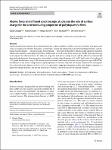Thông tin tài liệu
Thông tin siêu dữ liệu biểu ghi
| Trường DC | Giá trị | Ngôn ngữ |
|---|---|---|
| dc.contributor.author | Giada, Caniglia | - |
| dc.contributor.author | Andrea, Teuber | - |
| dc.contributor.author | Holger, Barth | - |
| dc.date.accessioned | 2023-04-20T08:55:26Z | - |
| dc.date.available | 2023-04-20T08:55:26Z | - |
| dc.date.issued | 2023 | - |
| dc.identifier.uri | https://link.springer.com/article/10.1007/s00216-022-04431-7 | - |
| dc.identifier.uri | https://dlib.phenikaa-uni.edu.vn/handle/PNK/8169 | - |
| dc.description | CC BY | vi |
| dc.description.abstract | Antibacterial polymer materials have gained interest due to their capability to inhibit or eradicate biofilms with greater efficiency in comparison with their monomeric counterparts. Among the antimicrobial and anti-biofouling polymers, catecholamine-based polymers — and in particular polydopamine — have been studied due to their favorable adhesion properties, which can be tuned by controlling the pH value. In this study, we used atomic force microscopy (AFM)–based spectroscopy to investigate the relation between the adhesion properties and surface charge density and the pH of electrochemically deposited polydopamine films presenting a dissociation constant of polydopamine of 6.3 ± 0.2 and a point of zero charge of 5.37 ± 0.06. Furthermore, using AFM and attenuated total reflection-Fourier transform infrared spectroscopy (ATR-FTIR), the influence of the surface charge density of polydopamine on bacterial adhesion and biofilm formation was investigated. | vi |
| dc.language.iso | en | vi |
| dc.publisher | Springer | vi |
| dc.subject | ATR-FTIR | vi |
| dc.title | Atomic force and infrared spectroscopic studies on the role of surface charge for the anti-biofouling properties of polydopamine films | vi |
| dc.type | Book | vi |
| Bộ sưu tập | ||
| OER - Khoa học Tự nhiên | ||
Danh sách tệp tin đính kèm:

